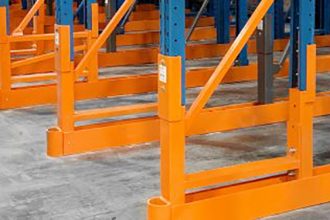Understanding Rack Decking Capacity Ratings

Intended to provide additional support for items stored on a pallet, decking products—such as welded wire, cold-formed light gauge, bar grating, and structural lumber—are placed on industrial steel storage rack beams to span the distance between them. Because decking is an accessory to a racking structure, the load calculations (capacity ratings) for it are different than those used to design and engineer a storage rack.
According to the original standard ANSI MH26.2-2017: Design, Fabrication, Testing and Utilization of Welded Wire Rack Decking published by RMI (note, this document is currently being revised as “Specification for the Design Testing and Utilization of Industrial Storage Rack Decking” to encompass all types of decking products), a buyer must submit the dimensional specifications and load capacity rating of the rack to the deck manufacturer prior to production.
This ensures that the decking will fit the system, and that the deck load capacity matches (or exceeds) the application. Not doing so can create a weak point in the system that is more likely to fail and cause a load to fall and potentially injure a worker.
The best practice for safety is to confirm that the decking’s capacity rating is at least identical to that of the rack load beams upon which it will be placed. For example, a beam pair rated for 5,000-pounds will typically require two decks rated at 2,500-pounds each to cover them. That’s because the load—or the pallet dimensions—stored upon the rack today could be completely different tomorrow, next year, or several years into the future. Unlike the rack structure, load capacity plaques are not required for rack decking, yet most users will assume the capacities are the same.
Therefore, the strength of the deck used for a pallet position should not be less than the rack rating of that pallet position. That’s because doing so would cause the maximum allowable stored pallet weight to be less than the rack rating—a conflict with the load value that appears on the load plaques and the rack configuration drawings. Best practice is that the deck strength is greater than or equal to the rack rating for an individual pallet position.
Currently, ANSI MH26.2-2017 notes that load capacity of wire decking is determined to be the “maximum uniformly distributed static load, independent of the support system.” The safe structural performance of the decking design is verified through a comprehensive testing procedure, outlined in section 7 of ANSI MH26.2-2017, which states:
“The uniformly distributed design load for the welded-wire rack decking shall be the lesser of the following:
a) the load at which maximum vertical deflections attain 1/165 of the depth of the welded-wire rack decking, ‘W1’;
b) one half of the tested ultimate load at which structural collapse of the welded-wire rack decking is attained, ‘W2’. This corresponds to an allowable strength with a safety factor of 2.0.”
Finally, for maximum safety, storage rack decking should never be used for anything other than uniformly distributed load storage. It is not engineered or constructed to be stood upon or walked across. For unique applications, such as hand stacking or point loading, a deck manufacturer can help design a deck to fit that particular use.
Looking for the full ANSI MH26.2-2017: Design, Fabrication, Testing and Utilization of Welded Wire Rack Decking standard? It is available for purchase, here.


